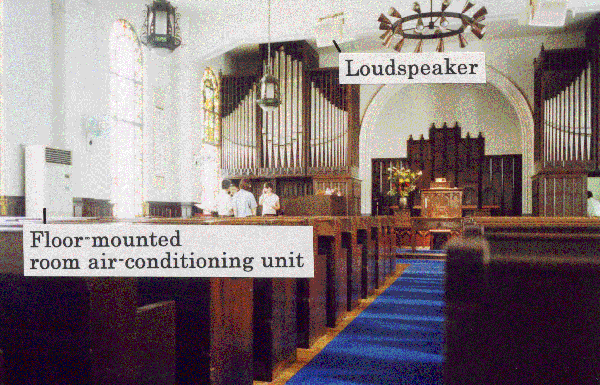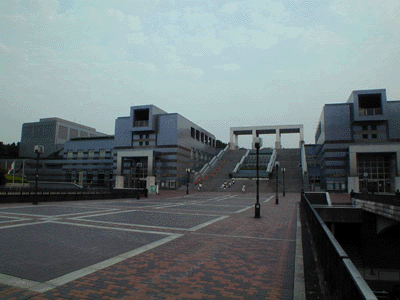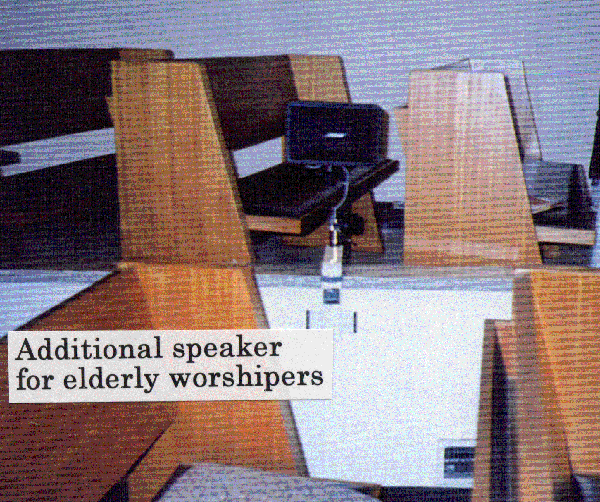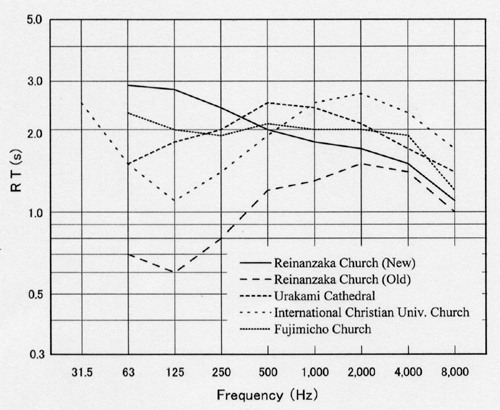
Title means "Quietness", "Comfortable Sound" and "Excellent Acoustics"
Nagata Acoustics News 01-9 (No.165)
Issued : September 25, 2001
Church Acoustics
by Dr. Minoru Nagata
Over the decades since I established Nagata Acoustics, we have been asked to provide advice on a variety of issues concerning church acoustics. For example, our first work on church acoustics was a strategy to insulate Kobe's Rokko Church sanctuary from external noise. Thereafter, we carried out the acoustical design of Reinanzaka Church and served as acoustical consultant throughout that project. We improved the speech clarity for sermons at the former Ignatio Church, and we redesigned the sound amplification system at Higashi Nakano Church to enable elderly parishioners to better hear sermons and other parts of the service. The objectives of our church acoustics consulting activities have been diverse.
Recently, in connection with the installation of pipe organs in Japanese churches, our church acoustics consulting has concentrated on evaluating and improving the reverberation characteristics of church sanctuaries. This work focuses on what may be considered the special and unique nature of church acoustics. The Matsuyama Church and St. Paul University's St. Margaret Chapel projects exemplify this recent trend in our church acoustics consulting.
In this article, I will highlight the acoustical issues faced by churches in Japan and present the special acoustical characteristics of church sanctuaries together with some fundamental guidelines applicable to both new church construction and renovations.
<< The Acoustics of Churches in Japan Today >>
While Japan has a few pre-World War II historical landmark church structures and a few churches that were built during Japan's impoverished early post-war years, the majority of actively used churches in Japan were constructed during Japan's economic revival and boom years. However, even for most of the newer structures, while they may install sound-absorbing materials on ceiling, floor-mounted room HVAC units and clubhouse or assembly hall-grade sound amplification systems, it is only very recently that church sanctuaries have begun to incorporate acoustical designs in their sanctuary design and building plans. The number of Japanese churches with professionally designed acoustics is still limited.
Church sanctuaries require both speech clarity for sermons and rich reverberations to enhance the sound of church music, and pipe organ music in particular. From an acoustical perspective, these two requirements are diametrically opposed. In Japan, we also face building restrictions such as limitations on building heights and the nearly ubiquitous budget constraints of most projects. Nevertheless, there is a lack of technical documentation available on the criteria for church sanctuary acoustics, and this deficit seems to be as true in Europe and the United States as it is in Japan. In addition, the field of acoustical engineering has yet to clarify and define accepted acoustical design principles for church sanctuaries. Given this situation, I will draw upon real-life examples to summarize below the acoustical challenges that arise in Japan in designing church sanctuaries.
(1) External noise and the need for sound insulation:
Church sanctuaries typically connect to the outside environment via a single layer of windows. This is insufficient to insulate the sanctuaries from external noise. I know of churches in Japan in which sermons cannot be heard at all because of the noise from traffic outside, or because the church is located in a neighborhood often used for demonstrations, parades or outdoor festivities and speeches. At one time, Tokyo's Ginza Church was plagued every Sunday by noise from the megaphone of a street-corner political activist. A recent survey of wood-constructed churches in central Tokyo revealed that external noise problems are still the norm. On average, the level of sound isolation for church structures is on the order of 30 dB (at 500 Hz).
(2) Noisy HVAC equipment:
Most churches use off-the-shelf, floor-mounted room HVAC units that, without any strategies to attenuate noise from heating fans and other noise-producing parts, raise the interior noise level above 45 dB (A). In the summer, some churches still rely on opened windows and fans to cool their sanctuaries.
(3) Sound amplification systems:
Most churches install assembly-hall or clubhouse-grade sound amplification equipment. Typically, the sound systems' speakers are column-style models that employ several generations' old technology, and the speakers' installation locations and the directions they face are often inappropriate. Many churches have two or three microphones set up on their daises for use during worship services, and they usually turn on all the microphones at the start of a service and keep them on throughout the service without the benefit of any mixing equipment.
Yumicho Hongo Church
 |
(4) Hearing difficulties for seniors:
Almost all of Japan's churches have a challenge in ensuring that elderly worshipers can hear the sermons and other parts of their worship services. Some churches have reserved specific seating areas for seniors, some make enhanced hearing headsets available and some have installed additional small speakers at strategic locations to help these worshipers' ability to fully experience church services.
(5) Use of absorptive ceiling materials and thin interior wall panels:
Some churches with pipe organs have absorptive material installed across the entirety of sanctuary ceilings and there are even examples of the upper open ends of organ pipes extending so close to absorptive ceiling material that the pipes and the ceiling almost touch. In addition, while church structures may be constructed of concrete, many have interior walls finished with thin drywall panels that vibrate when the church pipe organ is played, with the unfortunate result of shortening the reverberation time of lower octave sounds.
<< Reverberation Time in Church Acoustics >>
Examples of actual church reverberation characteristics are shown in the accompanying chart. The salient point here is the dramatic difference between church reverberation times and those of concert halls. The old Reinanzaka Church's reverberation characteristics typify those of Japan's wood-frame churches. A large number of recently built Japanese churches likewise also consider speech clarity the highest acoustical priority, as evidenced by their installation of sound absorbing materials in their sanctuaries.
<< Recommended Practices for Upgrading Church Acoustics >>
1. When the project calls for a new sanctuary, plan the space with as high a ceiling height as possible.
2. Depending on the external surroundings of the church and its site, use either airtight, sound-insulating window sashes or double sashes. Also, prevent air ducts from transmitting noise by using sound-absorbing ducts.
3. Depending on the size and scale of the sanctuary, the ideal HVAC system to choose is a ducted system. Since state-of-the-art room HVAC units now operate much more quietly than their predecessors, replacing a current HVAC system with a quieter one is a worthwhile strategy that should be included for consideration in a church's upgrade plans.
4. Avoid the use of absorptive ceiling materials and thin interior wall paneling. Use exposed concrete surfaces wherever possible for walls, floors and ceilings, especially in areas near a pipe organ. If the floor is to be finished with paneling, use panels that are sufficiently thick and sturdy. As a rule of thumb, use three 12mm (0.5 in.) panels bonded together, or 36 mm (1.4 in.) thickness as a minimum standard for floor paneling and choose materials and design that provide a thickness of 45 mm (1.8 in.) or above for the combined floor paneling and the concrete or other under-floor material.
5. Church decision makers first need to recognize that sound amplification systems play a critical role in determining the clarity and quality of how sermons sound. Within the category of sound system design, selecting the specific speaker model(s) and the locations where they will be installed are the most important decisions required. The advice of a professional acoustician should always be solicited and followed for these important decisions.
<< Two Examples from Nagata Acoustics Work >>
Matsuyama Church was originally constructed in 1986. In 1994, the church implemented a renovation project at the request of its pipe organ builder. As the acoustical consultants for this project, we devised a strategy with two significant changes to the interior wall and ceiling treatments: (1) We removed the thin board paneling that covered the wall behind the organ, exposing the concrete wall behind it. (2) We used sound reflecting material to close openings in the ceiling that had been made to expose the absorptive ceiling panels installed above the ceiling. Through these two measures, we worked to lengthen the reverberation time of the pipe organ's lower octaves.
St. Margaret's Chapel is a wood structure built around the late 1920s. Our acoustical consulting advice on this project concentrated on suppressing vibrations of the walls and the dais floor. The wall behind the dais (at the front of the chapel) is decorated with relief carving that dates from the original construction of the church. Because the church required us to preserve the relief carving intact, the construction work we directed to enhance the rigidity of the dais floor and chapel walls proceeded with many precautions and constraints that added to the challenge of this project. As part of the same project, Nagata Acoustics also managed the installation and related construction work for the chapel's new pipe organ. More details about this project can be found in our May 1999 "News and Opinions" (No. 137 in the Back Numbers).
<< Making Room for Acoustics in Church Building and Renovation Plans >>
Despite the importance of making room for the special acoustical characteristics of church sanctuaries, connections between the field of acoustical design and church projects have been all too sparse and weak. There are too many examples of large sums of money spent on churches in ways that diminish sanctuaries' acoustical quality, or where acoustical building materials have been misused, or doors and windows designed and installed without concern for the basics of sound insulation, or HVAC systems decided without a thought about noise control. When I see or learn of these examples, I can only regret that these churches' leaders and administrators did not consult with a professional acoustical consultant during the planning stage of their construction or renovation. Nagata Acoustics is an easily approachable company. We would welcome the opportunity to discuss religious organizations' building projects and plans to help avoid these and other acoustical blunders.
Parthenon Tama as it Nears its 15th Year
by Keiji Oguchi
Parthenon Tama
 |
Looking south from the main train station of Tama New Town, a suburban Tokyo bed-town, one sees first a softly rolling hill and then the striking view of a long stairway crowned by a traditionally Greek-design pergola and the building that spreads like two wings to the east and west. The structure is Tama City's cultural center, named Parthenon Tama, which celebrates its 15th anniversary in October 2002.
<< A Cultural Center and Hilltop Park >>
Parthenon Tama was built into the north side of the hill by carving away a portion of the hill and making room for the 15,000 sq. m. (161,460 sq. ft) cultural facility. The cultural center includes a large hall, a small hall, and a museum. The long, wide, outdoor staircase leads to the roof of the building and from there to a public park atop the hill.
<< My Visit to Parthenon Tama for this Article >>
I had not visited Parthenon Tama for a long time when I arrived on a recent weekday afternoon to interview its executive director, Mr. Ishizaka, its senior manager, Mr. Enomoto and another manager, Mr. Tagawa. We talked as we walked through Parthenon Tama's park. From the hilltop vantage, I could see a building that used to be the Tama Branch of Sogo Department Store, now out of business and replaced partially by Otsuka Furniture Store and partially by a Mitsukoshi Department Store branch. The relatively large number of people, mostly women, in the park, impressed me, considering that this was a weekday afternoon.
<< Parthenon Tama's Two Halls >>
Parthenon Tama's large hall has a seat count of 1,414 and a "one slope" configuration. It is a multipurpose hall designed with a free span. Sound reflectors are suspended above the stage as usual as in Japanese multipurpose hall, but the high height of the ceiling reflectors (11m. [36 ft] above the stage) and the ability to change the depth of the rear-stage reflection panels give this hall two unique acoustical design features.
The Parthenon Tama small hall has a seat count of 304. In order to accentuate audience-viewing ease, the floor of this hall's audience section is designed with a comparatively steep angle. This hall also has sound reflectors suspended above its stage.
Both of Parthenon Tama's halls are multipurpose halls, but we designed the large hall with the equivalent functionality of a specialty concert hall and the small hall with the focus on use by local residents and amateur community groups, thereby giving each of the halls its own clear purpose and distinctive characteristics. Today, it might be a matter of course to hammer out a hall's "personality" even before design work begins, but when the Parthenon Tama project began in 1982, this approach was still novel.
<< Performance Planning that Matches the Two Halls' Personalities >>
Naturally, the profile of each Parthenon Tama hall that guided its design has also infused the cultural center's performance planning activities from the center's inaugural commemoration until today. Parthenon Tama uses the three-genre approach of music, theater and film to plan the programming it develops. The cultural center's administration adopted a producer-based programming proposal process from the start of its planning for Parthenon Tama's inaugural events, and this program development method resulted in inspired programs in each of the three genres.
Among Parthenon Tama's performance series in the music genre are the New Japan Philharmonic's Tama Subscription Concerts, the Salon Concerts series now in its 12th year and the "Summer Live" concerts performed on a temporary outdoor stage in the hilltop park. The theater genre is well represented with musical theater performances by Japan's Theater Shiki and Theater Festival in the small hall. The small hall's Theater Festival selects the young, small theatre troupes that participate in each festival using a unique process. Community volunteers form a "Theatre Troupe Search Committee" and attend performances by candidate theatre troupes. The committee then determines which troupes to invite. In Japan, it is rather unusual for a facility such as Parthenon Tama to rely on local community members to decide which artists will be invited to perform at a hall-sponsored festival. For its film genre performances, Parthenon Tama obtained a second-level film license that gives it access to films that have completed their initial "road show" runs. The cultural center periodically hosts "Cine Salon" showings of popular films.
<< Examples of Parthenon Tama's Large Hall Performances >>
During the past 15 years I have attended a number of performances at Parthenon Tama. Some of the most memorable were Maestro Seiji Ozawa and the New Japan Philharmonic's performance of "Daphnis and Chloe," a stern performance by Maestro Celibidache performance with the Munich Philharmonic, the Jessie Norman recital at which she wowed the audience with a Black gospel piece as her encore, and an uncanny performance of "Jesus Christ Superstar" that used traditional Japanese kimono for its costumes. When one thinks about the large hall having just 1,414 seats, it is readily apparent that concerts held there offer the enjoyment of a level of intimacy that is a true luxury.
<< Adapting to the Leaner Budgets of Recent Years >>
In recent years, Parthenon Tama has felt the effects of Japan's recession through decreased funding from Tama City. In response, the cultural center changed its producer-based planning process to a less costly approach of consulting with external advisors. The cultural center also put the "Summer Live" concerts on hold because of the added expenses required for outdoor performances. But most of the performance series that the cultural center developed in its early years continue and some are flourishing more than ever before.
<< Parthenon Tama Brings Orchestral Music to Western Tokyo >>
This year, the New Japan Philharmonic increased the number of performances in its Tama subscription series from three to five. Among Tokyo's numerous orchestras, the New Japan Philharmonic is one whose name has appeared on several previous occasions in Nagata Acoustics' "News and Opinions" articles. In particular, we mentioned the New Japan Philharmonic in connection with the Sumida Tri-phony Hall Project, now the orchestra's home hall, in the Kinshicho section of Tokyo. The New Japan Philharmonic performs subscription concerts in Kinshicho, on the eastern side of sprawling metropolitan Tokyo, at Orchard Hall, in central Tokyo's Shibuya Ward, and at Parthenon Tama, near the western end of the Tokyo metropolitan area. The Tama subscription series makes it easier for fans who live on the western side of Tokyo to attend New Japan Philharmonic concerts and it also brings world-class orchestra conductors closer to the homes of this part of the Tokyo population. Residents of points further west, such as Kawasaki and Sagamihara, also enjoy the closeness of Parthenon Tama's location, and are among the orchestra's concert subscribers. Subscription concertgoers appreciate the parking discount honored by nearby parking facilities for concert tickets with purchase prices of \2,000 or more.
Another recent addition to Parthenon Tama's calendar is the Japan Chamber Orchestra (JCO). Two years ago, this orchestra began performing at Parthenon Tama, its sole performance venue. This incredible ensemble is a group of young musicians who perform together without being led by a conductor. They perform a wide repertoire, from centuries old works to modern compositions, and all their programs are works scored for full orchestras.
Originally, the JCO got its start as the resident orchestra at Oji Hall, on Tokyo's downtown Ginza, where it performed mostly contemporary music. But this arrangement lasted only about two years. Then two of the JCO's musicians, Tatsuya Yabe, Tokyo Metropolitan Orchestra Concert Master, and Masaji Yamamoto, New Japan Philharmonic clarinetist, they performed from time to time in Parthenon Tama's Salon Concerts series, apparently approached Parthenon Tama about having the JCO perform on a more regular basis and were able to establish the new concert series. The JCO's fifth Parthenon Tama concert was held on Saturday, September 22, 2001, and continued both a Beethoven symphony cycle begun at the JCO's third concert in the series, and a Beethoven piano concerto cycle begun at the previous, fourth concert. This is an exciting series of concerts I, too, want to attend.
<< Parthenon Tama's Strong Popularity and PR Activities >>
According to Parthenon Tama's administration, the cultural center's proactive approach to planning keeps both the large and small halls at about an 80% utilization rate. The cultural center publishes a colorful newsletter designed with eye-catching graphics that it distributes as a newspaper supplement both throughout Tama City and surrounding areas. The newsletter's circulation reaches 400,000 copies per issue.
<< The Museum Is a Treat for Music Lovers >>
Visitors to Parthenon Tama's museum will find "music" listed as a keyword among its themes. In a room named "Magic Sound Lab," visitors can enjoy listening to music "performed" by eight different self-playing instruments, each of which was crafted more than 100 years ago. The two violins, each of which uses a different method to achieve its automation, are particularly fun to hear and watch. These rare instruments are kept in excellent condition and because the instruments and music included in each performance change regularly, the Magic Sound Lab has its own coterie of repeat visitors.
<< Future Plans Stay in Touch with Tama City's Future Demographics >>
I asked the Parthenon Tama administrators what special challenges they face in operating a hall and cultural center in the suburbs of cosmopolitan Tokyo. As one might expect, they replied that younger Tama City residents tend to go into downtown Tokyo for their live entertainment, so Parthenon Tama concentrates on developing programming that will appeal to middle age and older residents, as well as to stay-at-home moms. In the future, Parthenon Tama also aims to develop stronger ties with colleges and companies that have decided to move out of the Tokyo downtown area and establish new campuses and headquarters in Tama City, with its quality of life advantages.
Throughout my interview I was aware of Parthenon Tama's ever present balancing act between the need to keep a lid on expenses and the desire to keep all its wonderful programming alive. I hope that this cultural center will be able to continue its strong and popular programming for many years to come.
More information on Parthenon Tama can be found at www.parthenon.or.jp.
E-mail Distribution of Nagata Acoustics News & Opinions
We hope you have enjoyed this News & Opinions newsletter, available each month on our web-site (http://www.nagata.co.jp). We also offer e-mail delivery of the text version of this newsletter. To receive the text newsletter to your e-mail address, simply send the following information to us at "newsmail_e@nagata.co.jp"
(1) Your e-mail address
(2) Your name
(3) The name of your company
By requesting the text version via e-mail, you will automatically receive every newsletter and you can still get the visuals and graphics at our web-site.
Nagata Acoustics News 01-9(No.165)
Issued : September 25, 2001
Nagata Acoustics Inc.
Hongo Segawa Bldg. 3F, 2-35-10
Hongo, Bunkyo-ku, Tokyo 113-0033 Japan
Tel: +81-3-5800-2671, Fax: +81-3-5800-2672
E-mail: info@nagata.co.jp






